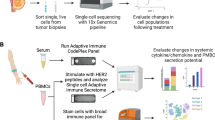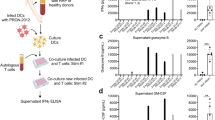Abstract
We describe the construction and evaluation of a recombinant hepatitis B surface antigen (HBsAg)-vectored DNA vaccine encoding the E7 and E6 tumor-associated oncoproteins of human papillomavirus (HPV) type 16. We show the induction of effector and memory cytotoxic T lymphocyte responses to E7 and E6 class I-restricted epitopes after a single immunization, which were associated with tumor prevention and therapy. The findings vindicate the use of a HBsAg-based DNA vaccine as a vehicle to elicit responses to co-encoded tumor antigens, and have specific implications for the development of a therapeutic vaccine for HPV-associated squamous carcinomas.
This is a preview of subscription content, access via your institution
Access options
Subscribe to this journal
Receive 12 print issues and online access
$259.00 per year
only $21.58 per issue
Buy this article
- Purchase on Springer Link
- Instant access to full article PDF
Prices may be subject to local taxes which are calculated during checkout







Similar content being viewed by others
References
Slebos RJ, Lee MH, Plunkett BS, Kessis TD, Williams BO, Jacks T et al. p53-dependent G1 arrest involves pRB-related proteins and is disrupted by the human papillomavirus 16 E7 oncoprotein. Proc Natl Acad Sci USA 1994; 91: 5320–5324.
Scheffner M, Huibregtse JM, Vierstra RD, Howley PM . The HPV-16 E6 and E6-AP complex functions as a ubiquitin-protein ligase in the ubiquitination of p53. Cell 1993; 75: 495–505.
Von Knebel DM, Rittmuller C, Aengeneyndt F, Jansen-Durr P, Spitkovsky D . Reversible repression of papillomavirus oncogene expression in cervical carcinoma cells: consequences for the phenotype and E6-p53 and E7-pRB interactions. J Virol 1994; 68: 2811–2821.
Ada G . The coming of age of tumor immunotherapy. Immunol Cell Biol 1999; 77: 180–185.
Rosenberg SA . Progress in human tumor immunology and immunotherapy. Nature 2001; 411: 380–384.
Feltkamp MC, Vreugdenhil GR, Vierboom MP, Ras E, van der Burg SH, ter Schegget J et al. Cytotoxic T lymphocytes raised against a subdominant epitope offered as a synthetic peptide eradicate human papillomavirus type 16-induced tumors. Eur J Immunol 1995; 25: 2638–2642.
Doan T, Herd K, Ramshaw I, Thomson S, Tindle RW . A polytope DNA vaccine elicits multiple effector and memory CTL responses and protects against human papillomavirus 16 E7-expressing tumor. Cancer Immunol Immunother 2005; 54: 157–171.
Lin KY, Guarnieri FG, Staveley-O’Carroll KF, Levitsky HI, August JT, Pardoll DM et al. Treatment of established tumors with a novel vaccine that enhances major histocompatibility class II presentation of tumor antigen. Cancer Res 1996; 56: 21–26.
Chu NR, Wu HB, Wu T, Boux LJ, Siegel MI, Mizzen LA . Immunotherapy of a human papillomavirus (HPV) type 16 E7-expressing tumor by administration of fusion protein comprising Mycobacterium bovis bacille Calmette-Guerin (BCG) hsp65 and HPV16 E7. Clin Exp Immunol 2000; 121: 216–225.
Greenstone HL, Nieland JD, deVisser KE, DeBruijn ML, Kirnbauer R, Roden RB et al. Chimeric papillomavirus virus-like particles elicit antitumor immunity against the E7 oncoprotein in an HPV16 tumor model. Proc Natl Acad Sci USA 1998; 95: 1800–1805.
van Driel WJ, Ressing ME, Kenter GG, Brandt RM, Krul EJ, van Rossum AB et al. Vaccination with HPV16 peptides of patients with advanced cervical carcinoma: clinical evaluation of a phase I-II trial. Eur J Cancer 1999; 35: 946–952.
Borysiewicz LK, Fiander A, Nimako M, Man S, Wilkinson GW, Westmoreland D et al. A recombinant vaccinia virus encoding human papillomavirus types 16 and 18, E6 and E7 proteins as immunotherapy for cervical cancer. Lancet 1996; 347: 1523–1527.
Peng S, Tomson TT, Trimble C, He L, Hung CF, Wu TC . A combination of DNA vaccines targeting human papillomavirus type 16 E6 and E7 generates potent antitumor effects. Gene Ther 2006; 13: 257–265.
Herd KA, Harvey T, Khromykh AA, Tindle RW . Recombinant Kunjin virus replicon vaccines induce protective T-cell immunity against human papillomavirus 16 E7-expressing tumor. Virology 2004; 319: 237–248.
Echchannaoui H, Bianchi M, Baud D, Bobst M, Stehle JC, Nardelli-Haefliger D . Intravaginal immunization of mice with recombinant Salmonella enterica serovar Typhimurium expressing human papillomavirus type 16 antigens as a potential route of vaccination against cervical cancer. Infect Immun 2008; 76: 1940–1951.
Daftarian PM, Mansour M, Pohajdak B, Fuentes-Ortega A, Korets-Smith E, Macdonald L et al. Rejection of large HPV-16 expressing tumors in aged mice by a single immunization of VacciMax encapsulated CTL/T helper peptides. J Transl Med 2007; 5: 26.
Chen CH, Wang TL, Ji H, Hung CF, Pardoll DM, Cheng WF et al. Recombinant DNA vaccines protect against tumors that are resistant to recombinant vaccinia vaccines containing the same gene. Gene Ther 2001; 8: 128–138.
Roy MJ, Wu MS, Barr LJ, Fuller JT, Tussey LG, Speller S et al. Induction of antigen-specific CD8+ T cells, T helper cells, and protective levels of antibody in humans by particle-mediated administration of a hepatitis B virus DNA vaccine. Vaccine 2000; 19: 764–778.
Schirmbeck R, Reimann J . Alternative processing of endogenous or exogenous antigens extends the immunogenic, H-2 class I-restricted peptide repertoire. Mol Immunol 2002; 39: 249–259.
Sbai H, Schneider J, Hill AV, Whalen RG . Role of transfection in the priming of cytotoxic T-cells by DNA-mediated immunization. Vaccine 2002; 20: 3137–3147.
Woo WP, Doan T, Herd KA, Netter HJ, Tindle RW . Hepatitis B surface antigen vector delivers protective cytotoxic T-lymphocyte responses to disease-relevant foreign epitopes. J Virol 2006; 80: 3975–3984.
Peng S, Trimble C, Alvarez RD, Huh WK, Lin Z, Monie A et al. Cluster intradermal DNA vaccination rapidly induces E7-specific CD8(+) T-cell immune responses leading to therapeutic antitumor effects. Gene Ther 2008; 15: 1156–1166.
Rice J, Ottensmeier C, Stevenson FK . DNA vaccines: precision tools for activating effective immunity against cancer. Nat Rev Cancer 2008; 8: 108–120.
Peng S, Ji H, Trimble C, He L, Tsai YC, Yeatermeyer J et al. Development of a DNA vaccine targeting human papillomavirus type 16 oncoprotein E6. J Virol 2004; 78: 8468–8476.
Feltkamp MC, Smits HL, Vierboom MP, Minnaar RP, de Jongh BM, Drijfhout JW et al. Vaccination with cytotoxic T lymphocyte epitope-containing peptide protects against a tumor induced by human papillomavirus type 16-transformed cells. Eur J Immunol 1993; 23: 2242–2249.
Cassetti MC, McElhiney SP, Shahabi V, Pullen JK, LePoole IC, Eiben GL et al. Antitumor efficacy of Venezuelan equine encephalitis virus replicon particles encoding mutated HPV16 E6 and E7 genes. Vaccine 2004; 22: 520–527.
Shi W, Bu P, Liu J, Polack A, Fisher S, Qiao L . Human papillomavirus type 16 E7 DNA vaccine: mutation in the open reading frame of E7 enhances specific cytotoxic T-lymphocyte induction and antitumor activity. J Virol 1999; 73: 7877–7881.
Tindle RW, Croft S, Herd K, Malcolm K, Geczy AF, Stewart T et al. A vaccine conjugate of ‘ISCAR’ immunocarrier and peptide epitopes of E7 cervical cancer-associated protein of human papillomavirus type 16 elicits specific Th1- and Th2-type responses in immunized mice in the absence of oil-based adjuvants. Clin Exp Immunol 1995; 101: 265–271.
Bosch FX, Lorincz A, Munoz N, Meijer CJ, Shah KV . The causal relation between human papillomavirus and cervical cancer. J Clin Pathol 2002; 55: 244–265.
Frazer IH . Prevention of cervical cancer through papillomavirus vaccination. Nat Rev Immunol 2004; 4: 46–54.
Fernando GJ, Stewart TJ, Tindle RW, Frazer IH . Th2-type CD4+ cells neither enhance nor suppress antitumor CTL activity in a mouse tumor model. J Immunol 1998; 161: 2421–2427.
Fiander AN, Tristram AJ, Davidson EJ, Tomlinson AE, Man S, Baldwin PJ et al. Prime-boost vaccination strategy in women with high-grade, noncervical anogenital intraepithelial neoplasia: clinical results from a multicenter phase II trial. Int J Gynecol Cancer 2006; 16: 1075–1081.
Tindle RW . Immune evasion in human papillomavirus-associated cervical cancer. Nat Rev Cancer 2002; 2: 59–65.
Muderspach L, Wilczynski S, Roman L, Bade L, Felix J, Small LA et al. A phase I trial of a human papillomavirus (HPV) peptide vaccine for women with high-grade cervical and vulvar intraepithelial neoplasia who are HPV 16 positive. Clin Cancer Res 2000; 6: 3406–3416.
Cavallo F, Offringa R, van der Burg SH, Forni G, Melief C . Vaccination for treatment and prevention of cancer in animal models. Adv Immunol 2006; 90: 175–213.
Henriksen E . The lymphatic spread of carcinoma of the cervix and of the body of the uterus; a study of 420 necropsies. Am J Obstet Gynaecol 1949; 58: 924–942.
Davis HL, Brazolot Millan CL, Mancini M, McCluskie MJ, Hadchouel M, Comanita L et al. DNA-based immunization against hepatitis B surface antigen (HBsAg) in normal and HBsAg-transgenic mice. Vaccine 1997; 15: 849–852.
Bryder K, Sbai H, Nielsen HV, Corbet S, Nielsen C, Whalen RG et al. Improved immunogenicity of HIV-1 epitopes in HBsAg chimeric DNA vaccine plasmids by structural mutations of HBsAg. DNA Cell Biol 1999; 18: 219–225.
Leclerc C, Deriaud E, Rojas M, Whalen RG . The preferential induction of a Th1 immune response by DNA-based immunization is mediated by the immunostimulatory effect of plasmid DNA. Cell Immunol 1997; 179: 97–106.
Gray D, Kosco M, Stockinger B . Novel pathways of antigen presentation for the maintenance of memory. Int Immunol 1991; 3: 141–148.
Bins AD, Jorritsma A, Wolkers MC, Hung CF, Wu TC, Schumacher TN et al. A rapid and potent DNA vaccination strategy defined by in vivo monitoring of antigen expression. Nat Med 2005; 11: 899–904.
Davis HL, Mancini M, Michel ML, Whalen RG . DNA-mediated immunization to hepatitis B surface antigen: longevity of primary response and effect of boost. Vaccine 1996; 14: 910–915.
Liu Y, Simsek E, Norton P, Sinnathamby G, Philip R, Block T et al. The role of the downstream signal sequences in the maturation of the HBV middle surface glycoprotein: development of a novel therapeutic vaccine candidate. Virology 2007; 365: 10–19.
McMichael AJ . The original sin of killer T cells. Nature 1998; 394: 421–422.
Appay V, Douek DC, Price DA . CD8+ T cell efficacy in vaccination and disease. Nat Med 2008; 14: 623–628.
Narayan S, Choyce A, Fernando GJ, Leggatt GR . Secondary immunization with high-dose heterologous peptide leads to CD8 T cell populations with reduced functional avidity. Eur J Immunol 2007; 37: 406–415.
Hariharan K, Braslawsky G, Black A, Raychaudhuri S, Hanna N . The induction of cytotoxic T cells and tumor regression by soluble antigen formulation. Cancer Res 1995; 55: 3486–3489.
Nagoya S et al. Helper T cell-independent proliferation of CD8+ cytotoxic T lymphocytes transduced with an IL-1 receptor retrovirus. J Immunol 1994; 153: 1527–1535.
Shen Y, Fujimoto S . A tumor-specific Th2 clone initiating tumor rejection via primed CD8+ cytotoxic T-lymphocyte activation in mice. Cancer Res 1996; 56: 5005–5011.
Kast WM, Brandt RM, Drijfhout JW, Melief CJ . Human leucocyte antigen-A2.1 restricted candidate cytotoxic T lymphocte epitopes of HPV 16 E6 and E7 proteins identified by using the processing defective human cell line T2. J Immunother 1993; 14/2: 115–120.
Acknowledgements
A Gould and R Tindle contributed equally to this work and should be regarded as joint senior authors. The work was supported by funds from the National Health and Medical Research Council (NHMRC), Australia, project grant #401526 and the Royal Children's Hospital Foundation (Brisbane). O Haigh is in receipt of a University of Queensland PhD scholarship. We thank the staff of the Herston Medical Research Centre for animal husbandry. Contribution no. 337 of the Sir Albert Sakzewski Virus Research Centre.
Author information
Authors and Affiliations
Corresponding author
Ethics declarations
Competing interests
The authors declare no conflict of interest.
Rights and permissions
About this article
Cite this article
Haigh, O., Kattenbelt, J., Cochrane, M. et al. Hepatitis B surface antigen fusions delivered by DNA vaccination elicit CTL responses to human papillomavirus oncoproteins associated with tumor protection. Cancer Gene Ther 17, 708–720 (2010). https://doi.org/10.1038/cgt.2010.27
Received:
Revised:
Accepted:
Published:
Issue Date:
DOI: https://doi.org/10.1038/cgt.2010.27
Keywords
This article is cited by
-
Hepatitis B virus surface antigen as delivery vector can enhance Chlamydia trachomatis MOMP multi-epitope immune response in mice
Applied Microbiology and Biotechnology (2014)



